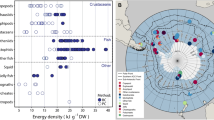Abstract
Digestion times and assimilation efficiencies are critical factors used in calculations of carbon and nitrogen budgets. Digestion times of natural copepod prey differed significantly among 4 genera of siphonophores (P>0.001), from a minimum of 1.6 h to a maximum of 9.6 h. Assimilation efficiencies, in contrast, were uniformly high; 87 to 94% for carbon and 90 to 96% for nitrogen. Nitrogen assimilation was consistently greater than carbon assimilation. Assimilation efficiencies calculated according to dry weight substantially underestimated assimilation of carbon and nitrogen, while calculations using ash-free dry weights and ash-free to dry weight ratios approached values for carbon assimilation. These values are appreciably higher than most of the assimilation efficiencies previously measured for a few other planktonic carnivores. These results indicate very efficient digestion of food by siphonophores in oceanic environments where prey densities are low.
Similar content being viewed by others
Literature Cited
Biggs, D. C.: Nutritional ecology of Agalma okeni and other siphonophores from the epipelagic western North Atlantic Ocean, 141 pp. Ph.D. Thesis, Massachusetts Institute of Technology and the Woods Hole Oceanographic Institution 1976
Biggs, D. C.: Field studies of fishing, feeding, and digestion in siphonophores. Mar. behav. Physiol. 4, 261–274 (1977a)
Biggs, D. C.: Respiration and ammonium excretion by open ocean gelatinous zooplankton. Limnol. Oceanogr. 22, 108–116 (1977b)
Biggs, D. C., R. R. Bidigare and D. E. Smith: Population density of gelatinous macrozooplankton: in situ estimation in oceanic surface waters. Biol. Oceanogr 1, 157–173 (1981)
Conover, R. J.: Assimilation of organic matter by zooplankton. Limnol. Oceanogr. 11, 338–345 (1966)
Conover, R. J.: Transformation of organic matter. In: Marine ecology IV. Dynamics, Ch.. Ed. by O. Kinne. New York: Wiley 1978
Conover, R. J. and C. M. Lalli: Feeding and growth in Clione limacina (Phipps) a pteropod molluse II. Assimilation, metabolism, and growth efficiency. J. exp. mar. Biol. Ecol. 16, 131–154 (1974)
Cosper, T. C. and M. R. Reeve: Digestive efficiency of the chaetognath Sagitta hispida Conant. J. exp. mar. Biol. Ecol. 17, 33–38 (1975)
Forster, J. R. M. and P. A. Gabbott: The assimilation of nutrients from compounded diets by the prawns Palaemen serratus and Panadalus platyceros J. mar. biol. Ass. U.K. 51, 943–961 (1971)
Hirota, J.: Quantitative natural history of Pleurobrachia bachei in La Jolla Bight. Fish. Bull., U.S. 72, 295–335 (1974)
Lasenby, D. C. and R. R. Langford: Feeding and assimilation of Mysis relicta. Limnol. Oceanogr. 18, 280–285 (1973)
Lasker, R.: Feeding, growth, respiration, and carbon utilization of a euphausiid crustacean. J. Fish. Res. Bd Can. 23, 1291–1317 (1966)
Mullin, M. M. and E. R. Brooks: Laboratory culture growth rate and feeding behavior of a planktonic marine copepod. Limnol. Oceanogr. 12, 657–666 (1967)
Purcell, J. E.: Influence of siphonophore behavior on their natural diets: evidence for aggressive mimicry. Science, N.Y. 209, 1045–1047 (1980)
Purcell, J. E.: Dietary composition and diel feeding patterns of epipelagic siphonophores. Mar. Biol. 65, 83–90 (1981a)
Purcell, J. E.: Feeding ecology of Rhizophysa eysenhardti a siphonophore predator of fish larvae. Limnol. Oceanogr. 26, 424–432 (1981b)
Purcell, J. E.: Selective predation and caloric consumption by the siphonophore Rosacea cymbiformis in nature. Mar. Biol. 63, 283–294 (1981c)
Purcell, J. E.: Feeding and growth in the siphonophore Muggiaea atlantica (Cunningham). J. exp. mar. Biol. Ecol. 62, 39–54 (1982)
Purcell, J. E. and P. Kremer. Feeding and metabolism of the siphonophore Sphaeronectes gracilis. J. Plankton Res. 5, 95–106 (1983)
Reeve, M. R.: Comparative experimental studies on the feeding of chaetognaths and ctenophores. J. Plankton Res. 2, 381–393 (1980)
Reeve, M. R., M. A. Walter and T. Ikeda: Laboratory studies of ingestion and food utilization in lobate and tentaculate ctenophores. Limnol. Oceanogr. 23, 740–751 (1978)
Sokal, R. R. and F. J. Rohlf: Biometry. The principles and practice of statistics in biological research, 776 pp. San Francisco: W. H. Freeman and Co. 1969
Author information
Authors and Affiliations
Additional information
Communicated by S. K. Pierce, College Park
Contribution no. 5298 from the Woods Hole Oceanographic Institution
Rights and permissions
About this article
Cite this article
Purcell, J.E. Digestion rates and assimilation efficiencies of siphonophores fed zooplankton prey. Mar. Biol. 73, 257–261 (1983). https://doi.org/10.1007/BF00392251
Accepted:
Issue Date:
DOI: https://doi.org/10.1007/BF00392251




